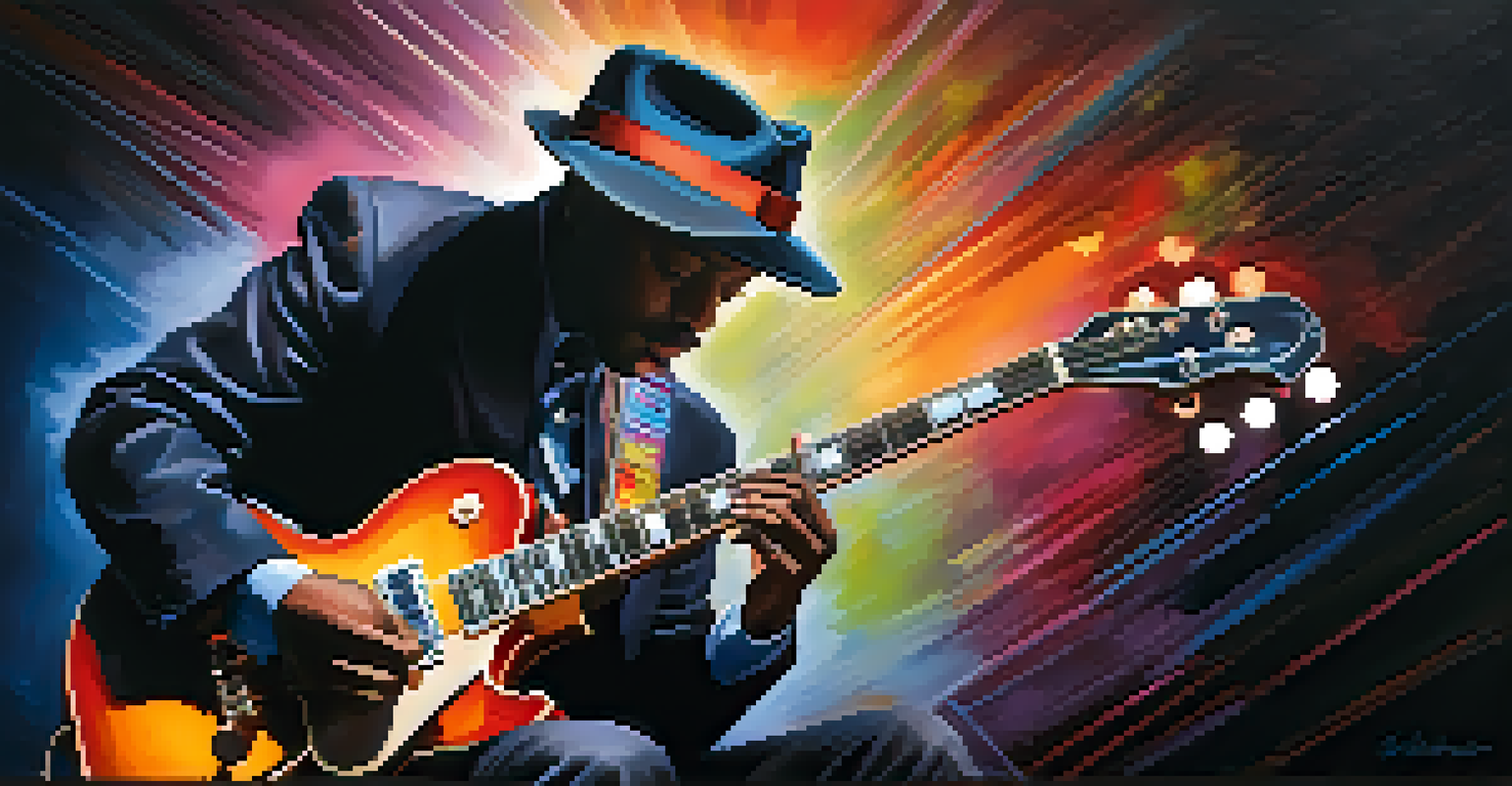Exploring Different Guitar Styles for Mindful Play

Understanding Mindful Play and Its Benefits
Mindful play is about being present and fully engaged while playing an instrument. It encourages you to focus on the music, your emotions, and the moment itself, rather than the end result. This approach can reduce anxiety and improve your overall enjoyment of playing guitar.
Music is the shorthand of emotion.
As you immerse yourself in the sounds and sensations of your guitar, you might find that distractions fade away. This practice allows you to connect deeply with the instrument, fostering creativity and self-expression. Mindful play can turn practice sessions into a meditative experience.
For example, instead of rushing through scales, try to feel each note resonate. This shift in perspective can lead to greater satisfaction and personal growth as a guitarist, making every session a journey of discovery rather than just a routine.
Exploring Acoustic Fingerstyle for Calm Focus
Acoustic fingerstyle is a gentle yet intricate playing technique that can enhance mindfulness. By using your fingers to pluck the strings, you create a rich tapestry of sound that invites deeper listening. The slow, deliberate movements required for this style encourage you to be present in the moment.

As you practice fingerstyle, the rhythmic patterns can become almost hypnotic. This repetitive motion allows your mind to quiet down, creating a serene atmosphere conducive to mindful play. Many guitarists find that this style helps them connect with their emotions and enhances their overall playing experience.
Mindful Play Enhances Musical Enjoyment
Engaging fully in the moment while playing an instrument can reduce anxiety and deepen your enjoyment of music.
Consider artists like Tommy Emmanuel, whose fingerstyle compositions evoke a sense of peace and introspection. By emulating such techniques, you can cultivate a mindful state that transforms your practice into a soothing ritual.
Jazz Guitar: Embracing Spontaneity and Creativity
Jazz guitar encourages improvisation, which can be a fantastic way to practice mindful play. In jazz, each note is a choice, and every chord transition invites you to respond to the moment. This spontaneous approach allows you to explore your feelings and thoughts as you create music in real-time.
The beautiful thing about learning is that no one can take it away from you.
Engaging with jazz guitar can help you let go of perfectionism and embrace experimentation. The beauty of jazz lies in its unpredictability, teaching you to trust your instincts and enjoy the process. This liberation can lead to a deeper connection with the music and your own artistic voice.
Listening to jazz legends like Wes Montgomery can inspire your improvisational journey. By diving into this style, you can cultivate a practice that is not only technically enriching but also emotionally fulfilling.
Classical Guitar: Finding Structure in Simplicity
Classical guitar offers a structured approach that can foster mindfulness through discipline. The precision required for this style encourages you to focus on technique and the subtleties of sound. This attention to detail can lead to a profound appreciation for each note and phrase.
Practicing classical pieces often involves slow, deliberate movements, allowing you to immerse yourself in the music. As you navigate through complex compositions, you develop patience and resilience, both crucial for mindful play. The calming nature of classical music can also create a peaceful environment for your practice.
Different Styles Foster Mindfulness
Various guitar styles, from acoustic fingerstyle to blues, encourage mindfulness through emotional expression and intentional practice.
Think of pieces by composers like Francisco Tárrega, whose works encourage exploration and emotional depth. By integrating classical guitar into your routine, you can find balance and tranquility in each practice session.
Blues Guitar: Expressing Emotion Through Sound
Blues guitar is deeply rooted in emotional expression, making it a powerful style for mindful play. The genre’s soulful riffs and heartfelt lyrics encourage you to tap into your own feelings while playing. This connection can lead to catharsis, allowing you to express what’s within you through music.
Practicing the blues often involves improvisational techniques that promote spontaneity. When you play a blues scale, you’re not just following notes; you’re telling a story. This storytelling aspect invites you to reflect on your experiences, fostering a mindful connection between your emotions and your guitar.
Artists like B.B. King exemplify how blues can convey deep feelings. By embracing this style, you can create a space for introspection and emotional release, enhancing your overall playing experience.
Folk Guitar: Connecting with Nature and Simplicity
Folk guitar is all about storytelling and simplicity, making it an ideal style for mindful play. The straightforward chords and melodies invite you to focus on the lyrics and emotions behind the music. This connection to the narrative can ground you in the moment, enhancing your listening experience.
As you strum along to folk tunes, you might find yourself reflecting on personal stories or the beauty of nature. This style encourages a sense of community and shared experience, making it perfect for gathering with friends or family. The relaxed nature of folk music can create a comforting atmosphere that promotes mindfulness.
Create a Purposeful Practice Routine
Incorporating intention and variety into your guitar practice can make each session more fulfilling and enriching.
Artists like Bob Dylan or Joan Baez exemplify how folk music captures the essence of human experience. By engaging with folk guitar, you can cultivate a sense of belonging and connection to both the music and those around you.
Rock Guitar: Harnessing Energy for Mindful Expression
While rock guitar is often associated with high energy, it can also be a platform for mindful expression. The raw emotion found in rock music allows you to channel your feelings through powerful riffs and solos. This dynamic energy can help you connect with your inner self while staying present in the moment.
Practicing rock guitar often involves playing with intensity, which can serve as a form of release. The powerful strumming and expressive solos invite you to immerse yourself fully, making the act of playing a cathartic experience. This approach fosters a mindset of mindfulness, where every strum and note matters.

Consider the music of Jimi Hendrix, whose passionate playing encourages emotional exploration. By embracing rock guitar, you can harness that energy to create a mindful practice that resonates with your personal experiences.
Creating Your Mindful Guitar Practice Routine
To incorporate mindful play into your guitar routine, consider dedicating specific time for each style. You might start with acoustic fingerstyle to warm up, followed by a session of jazz improvisation to spark creativity. This variety can keep your practice engaging and fulfilling, allowing you to explore different facets of your musicality.
Setting an intention before each practice session can also enhance mindfulness. Whether it's focusing on expressing emotion through blues or enjoying the simplicity of folk, having a clear goal helps direct your energy. This intentionality ensures that each moment spent with your guitar is purposeful and enriching.
Finally, remember to be patient with yourself. Mindful play is about the journey, not the destination. Allow yourself to explore, make mistakes, and grow, as this process will ultimately deepen your relationship with your guitar.